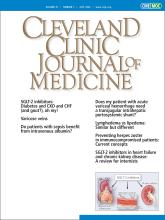To the Editor: We read with great interest the article by Bassil and colleagues1 on severe hyponatremia in the April issue. The authors state that in patients with chronic hyponatremia the rate of sodium correction should not exceed 6 to 8 mmol/L in the first 24 hours because of the risk of osmotic demyelination syndrome (ODS).
Two recent studies argue against slow correction, ie, 6 to 8 mmol/L per 24 hours. The first study looked at 22,858 patients with hyponatremia admitted to 5 Canadian hospitals.2 Rapid correction was common, occurring in 3,632 (17.7%) patients. Only 12 patients (0.05%) developed ODS, and of these, 7 did not have rapid correction of serum sodium.2
The second study included 3,274 patients with severe hyponatremia who presented to 2 US hospitals with sodium levels of less than 120 mmol/L.3 A correction rate greater than 10 mmol/L per 24 hours was associated with lower in-hospital mortality and shorter hospital length of stay in multivariate analysis. Seven patients developed ODS, and in 5 of these the correction rate was 8 mmol/L per 24 hours or less.3
Given the rarity of ODS and poor correlation with rapid correction, limiting correction to 6 to 8 mmol/L in the first 24 hours leads to frequent monitoring of electrolytes. Overcorrection leads to use of intravenous desmopressin and hypotonic fluids, which invariably leads to increased intensive care unit length of stay and possibly increased mortality. In light of the above evidence, shouldn’t the goals of correction in severe hyponatremia in the first 24 hours be liberalized?
- Copyright © 2024 The Cleveland Clinic Foundation. All Rights Reserved.






